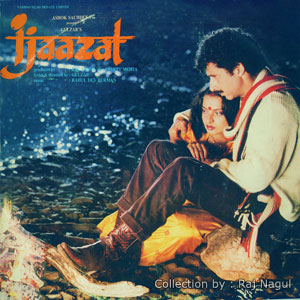Katra Katra

Song: “Katra katra milti hai”
Film: Ijaazat (1987)
Singer: Asha Bhosle
Lyricist: Gulzar
Producer: R.K. Gupta
Director: Gulzar
In life, if we get anything that meets our expectations, we become happy and it’s human tendency that we immediately share the feeling with someone who is very close to us. Also, while sharing or expressing the feeling, we express the feeling in a flow or words – “agar yeh huwa to aise hogathen aisa hoga,” then this and then that, and much more.
A similar situation appears in the life of Sudha (Rekha) in Gulzar’s Ijaazat, when she feels that Mahendra (Naseeruddin Shah) has love and affection for her in spite of the presence of Maya (Anuradha Patel) in his life.
One of the finest lyricists in Hindi film history, Gulzar pens a song for this sensitive situation, and the beautiful lyrics start with the words “Katra katra milti hai….” I think it must have posed a challenge to Pancham because the situation of the song is very sensitive, yet romantic, and the starting words are “Katra katra….” But then as we all are very well aware, Pancham, the genius that he was, used to understand the situation/location with all its underlying emotions and feelings and he must have instinctively understood Sudha’s feelings. And he has succeeded brilliantly in delivering those emotions and feelings expressed in the song.
The first interlude music (M0) of the song starts with a note on the flute, which creates the feather touch of happiness, followed by a combination of soft instruments that beautifully express Sudha’s happy state of mind.
Pancham has used all the soft instruments very effectively in this song, and in the vocal part of the mukhda and antara, he uses the voice-over-voice effect to convey the flow of feelings, happiness in this case, like I mentioned above − that is, “agar yeh huwa to aise hoga then aisa hoga.”I think the voice-over-voice technique is used in this song to effectively convey the feelings of the character and not just for the sake of using the technique.
The mukhda of the song − “Katra katra milti hai, katra katra jeene do, zindagi hai” − is very appropriate for the situation, and an apt tune to those words makes this melody divine. One noticeable thing is the rhythm pattern used. The words being so odd, it is really difficult to imagine a rhythm pattern suited to those words or the melody. But with Pancham anything is possible if it is a genuine requirement of the song, and I think for the first time this type of different rhythm using only the beats of drum base (octopad) is used, to accompany the words, to enhance the glaze of melody as well lyrics.
Pancham’s songs or music is immediately identified or distinguished by many aspects, and rhythm pattern is one of them. In the antara of “Katra katra,” Pancham has used nearly the same rhythm pattern as the one he used in “Tujhse naaraaz nahi zindagi” (Masoom– sung by Anup Ghosal) with a somewhat slow pace and slightly prominent use of the bass guitar, due to which “Katra katra touches the heart − very softly.
One of the major reasons why “Katra katra” becomes special and connects, like a heart-to-heart contact among the director, lyricist, actor, music director and listener, is the super-fine interlude music.
As usual, Pancham proves to be a master at making perfect interludes with smooth takeoff and perfect landing with the feather touch effect of the violin and flute and off-course the santoor, which adds very precious value to the journey of the song.
Pancham’s creative mind has identified the perfect place to explore the feelings of the character and, through his ever-fine interlude music, he also compels us to feel or visualize the excellent cinematic vision of the director as well as the beauty of the atmosphere and the location. (In a live interaction with a few of my friends, the director of the film, Gulzar, had mentioned that the song was shot in Kudremukh in Karnataka.)
In the third interlude, Pancham experiments by fusing electronic instruments with chorus, ending with the santoor to create the fog (kohra) effect, before Gulzar does the same through his lyrics – “Halke halke kohre ke dhuen mein….”
Pancham has taken full advantage of all three interludes, to take us to the location of Kudremukh, while experiencing the state of mind of Sudha.
The song does not end like any normal song. It ends with the voice-over-voice effect on Asha Bhosle’s “Rehene do na,” which keeps the song flowing, continuously, till the end.
With due respect to all the members of Pancham’s musical team, all those who are part of “Katra katra” − Gulzar, Asha Bhosle, cinematographer Ashok Mehta and others − deserve equal praise for making the song the phenomenon it is.
Well, on a slightly different note, I must say that whatever I have expressed here is a personal perception and interpretation and not an expert’s thesis or analysis.
Nitin Chabukswar
panchammagic.org

